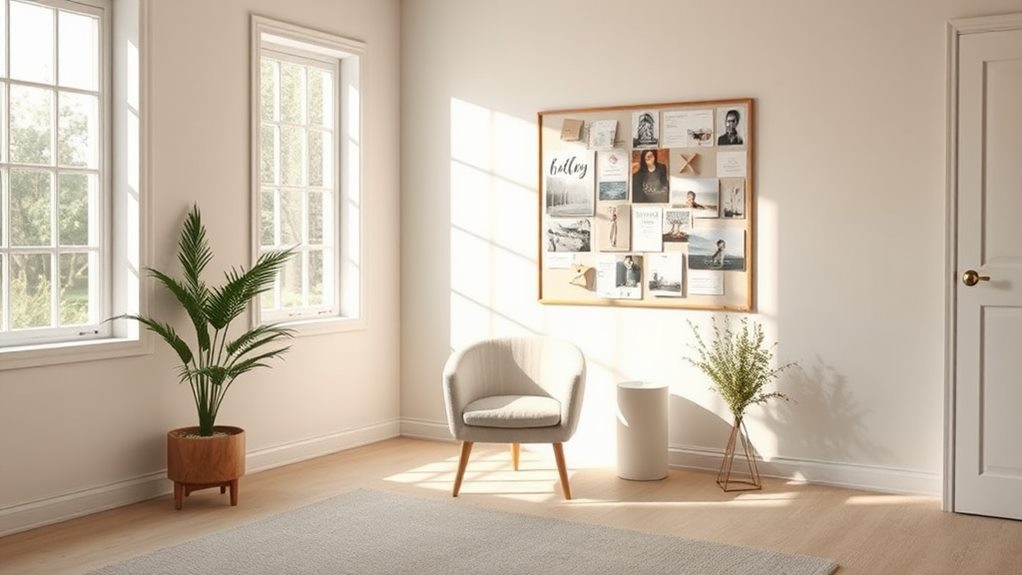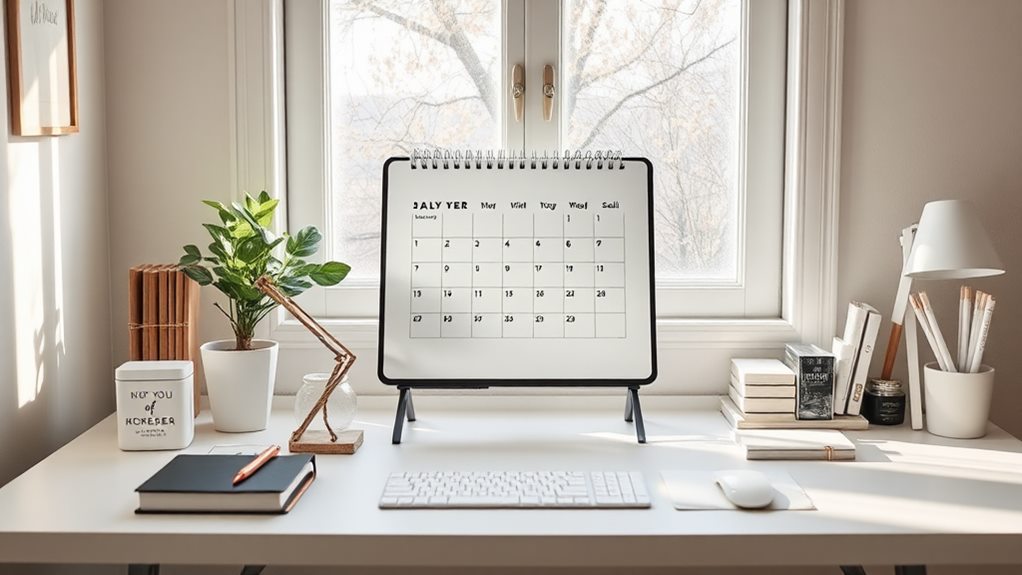When you're striving for a peaceful home, clutter can really get in the way. It's essential to have a vision for how you want your space to feel—think about the calm and order you crave.
One effective method to help you assess your belongings is the One-Year Rule. This rule suggests that if you haven't used an item in the past year, it might be time to let it go. This approach not only helps you clear out unnecessary items but also encourages you to be more mindful about what you keep.
To keep your decluttering efforts on track without feeling overwhelmed, creating a decluttering schedule can be incredibly helpful. For instance, you might decide to tackle one room or even one section of a room each week. This way, decluttering becomes a manageable task rather than an exhausting chore.
So, how do all these strategies come together to create the serene space you desire? By visualizing your goals, applying the One-Year Rule, and following a structured schedule, you can transform your environment into a calming oasis.
Each small step you take towards decluttering can lead to greater peace of mind and a more enjoyable living space. Let's dive deeper into how you can implement these tips effectively.
Key Takeaways
Here are some effective tips for decluttering your space to create a peaceful and serene environment:
First, take a moment to envision what your ideal space looks like. Think about the areas in your home that feel cluttered or chaotic. Identifying these spots is the first step toward transforming your surroundings into a calm sanctuary. For example, if your living room is filled with unnecessary knick-knacks, picture it as a serene oasis with minimal decor and open space.
Next, consider the one-year rule. This guideline suggests that you keep only the items you've used in the last year. By doing this, you can detach from emotional connections to things you no longer need, which helps reduce clutter. For instance, if you haven't worn a particular jacket in over a year, it might be time to let it go. This practice not only clears space but also allows you to appreciate the items you truly love and use.
When you begin the decluttering process, sorting your belongings into three categories—keep, donate, and discard—can make decision-making much easier. This method streamlines the process, helping you quickly identify what adds value to your life and what doesn't. For example, you might find that you can donate books you've already read or clothes that no longer fit.
To keep your space clutter-free, establish a regular decluttering routine. Setting aside time every month to reassess your belongings can help prevent clutter from piling up again. Whether it's a simple 15-minute tidy-up or a more extensive weekend project, consistency is key. You might even consider using a calendar app to remind you of these decluttering sessions.
Finally, if you're struggling to part with certain items, try taking photos of them before you let them go. This way, you can preserve the memory without the physical clutter. It's a simple yet effective way to achieve emotional release while maintaining a sense of peace in your space. For instance, snap a picture of your child's artwork before donating it; this way, you can cherish the memory without keeping the item.
By following these tips, you can create a tranquil environment that nurtures serenity and clarity in your life.
Start With a Vision

To kick off your minimalist decluttering journey, it's important to first have a clear idea of what you want to achieve.
Take a moment to think about your personal goals—what does a clutter-free space mean to you? Visualizing your ideal environment can truly help make that vision more tangible. You might find it helpful to create a mood board with images that inspire you or spend some time journaling about what you hope to accomplish. Imagine how refreshing it would feel to step into a calm, organized space every day.
Once you have this vision in mind, it's time to break it down into manageable steps.
Look around your home and pinpoint specific areas that need some attention. Whether it's your bedroom, kitchen, or workspace, prioritize where you want to start based on your goals. For instance, if your bedroom feels chaotic, focus on that first.
Make a list of tasks to tackle, and take them on one by one. This structured approach not only keeps you focused but also makes the process feel less overwhelming and more rewarding. Remember, each small victory brings you closer to your ideal space!
The One-Year Rule
Deciding what to keep and what to let go can be a tough process, but the One-Year Rule can help you simplify it. The idea is straightforward: if you haven't used an item in the past year, it might be time to reconsider its place in your home. Take a moment to reflect on each item and think about when you last found joy or need for it.
This strategy is particularly useful for tackling emotional attachments. Many of us cling to possessions because they remind us of certain moments or people, but if those items have been gathering dust for over a year, it's likely they're not enhancing your life. If you're hesitant to part with something, try taking a picture of it. This way, you can keep the memory alive without the physical clutter.
As you go through your stuff, set up three categories: keep, donate, and discard. Be honest with yourself here—if an item doesn't serve a purpose or spark joy, it's probably best to let it go.
Using the One-Year Rule not only helps declutter your space but also clears your mind. This practical approach allows you to create a calm environment where you can concentrate on what truly matters to you.
Create a Decluttering Schedule

Creating a decluttering schedule can really help turn what often feels like a chaotic mess into manageable tasks. Setting up a routine not only makes it easier to tackle the clutter but also helps you see progress without feeling overwhelmed. To start, think about which areas of your home need the most attention—maybe it's your closet that's bursting at the seams or your garage that's turned into a catch-all.
Here's a straightforward schedule to get you going:
| Day | Task |
|---|---|
| Monday | Clear out your closet |
| Wednesday | Organize your kitchen |
| Friday | Spruce up the living room |
| Sunday | Review what you've done and plan for next week |
Each of these tasks can be completed in about 30 minutes to an hour, depending on how much stuff you have. This structured approach means you won't feel swamped, and you can keep up with your decluttering efforts.
Adjust the schedule to fit your priorities—what matters most to you? Sticking to this routine not only helps clear your space but can also lead to a calmer mindset. As you keep at it, you'll likely notice how your environment feels lighter and less stressful. Remember, consistency is key; the more you maintain this schedule, the more you'll see clutter—and stress—reduce over time.
Frequently Asked Questions
How Do I Handle Sentimental Items While Decluttering?
When you're sorting through sentimental items, it's essential to focus on how to best preserve those memories. Start by grouping items into categories—this could be anything from family keepsakes to travel souvenirs. Next, select a few pieces that truly resonate with you; these are the items that bring back the most vivid memories or feelings. Instead of trying to keep everything, think about practical storage solutions. For instance, a memory box is a great way to keep physical items organized and safe. Alternatively, you might consider creating digital archives. By taking photos of items that hold sentimental value but don't need to take up physical space, you can still cherish those memories without the clutter. This approach helps you maintain a connection to your past while allowing your living space to remain organized and peaceful.
Can Decluttering Help Reduce Anxiety and Stress Levels?
Absolutely, decluttering can significantly help lower feelings of anxiety and stress. When you take the time to organize your living space, you're not just tidying up; you're also creating a clearer mental space. This clarity makes it much easier to concentrate on tasks and feel more in control of your environment. For example, if your workspace is cluttered with papers and miscellaneous items, it can be overwhelming and distracting. By sorting through these items and keeping only what you need, you can foster a more serene atmosphere that enhances your overall well-being.
Imagine walking into a room where everything has its place, and there's nothing extraneous to pull at your attention. That sense of order can bring about a calmness that allows you to breathe easier and think more clearly. Plus, there are plenty of helpful tools out there to assist you in this process. Consider investing in storage bins or organizers that can help keep your belongings sorted and easy to access.
Decluttering isn't just about a neat space; it's about nurturing your mental health. When your environment is peaceful, it can lead to a more balanced and positive mindset, making it easier to tackle life's challenges. So, if you're feeling overwhelmed, starting with a little decluttering might just be the perfect first step towards a more relaxed you.
What to Do With Items That I Can't Decide to Keep or Toss?
When you're faced with items that you're unsure about keeping or tossing, it helps to set some clear criteria for your decision-making. Consider factors like how often you use the item or the emotional value it holds for you. For instance, if you haven't touched a certain kitchen gadget in over a year, it might be time to let it go. You can also use a simple sorting system: create three categories—keep, donate, and toss. This method can make the process feel less overwhelming and help you quickly identify what truly matters to you.
If you're struggling with a sentimental item, think about its role in your life. Does it bring you joy, or is it just taking up space? For example, if you have a collection of old concert tickets, maybe choose the ones from the most memorable events and let the rest go. This way, you preserve the memories that mean the most without cluttering your space. Remember, the goal is to create an environment that reflects who you are today, not who you were in the past.
Should I Involve My Family in the Decluttering Process?
Getting your family involved in the decluttering process can really make a difference. When everyone pitches in, it creates a sense of teamwork and support that can lighten the load. For example, if you're sorting through old toys, ask your kids to help decide which ones they still play with and which ones can be donated. This way, they feel their opinions matter, and it can turn a chore into a fun activity.
Plus, working together on decluttering helps everyone share the responsibility. It's easier to make decisions when you have a partner in the process. Instead of feeling overwhelmed, you might find it enjoyable to reminisce about old items as you clear out space. So, gather your family and make it a team effort—it's not just about getting rid of stuff; it's about bonding and creating a more organized home together.
How Do I Maintain a Minimalist Lifestyle After Decluttering?
To keep a minimalist lifestyle going strong, it's essential to build habits that stick. One effective way is to schedule regular decluttering sessions. Think of it as an ongoing practice rather than a one-time event. For instance, you could set aside a little time each month to go through your belongings and see what you really need or what may no longer bring you joy.
Mindful consumption is another important aspect. Before making a purchase, ask yourself if it's something you genuinely need. For example, if you're considering a new gadget, think about whether it will genuinely enhance your life or if it's just a fleeting desire. This kind of reflection helps prevent clutter from creeping back into your home.
Additionally, regularly assessing your belongings can ensure that they continue to serve a purpose in your life. A good rule of thumb is to follow the "one in, one out" principle: when you acquire something new, let go of something else. This approach not only helps keep your space tidy but also reinforces the importance of thoughtful ownership.
Conclusion
To create a serene and minimalist space, it's essential to start with a clear vision of what you want your environment to feel like. Picture a calm, uncluttered room that allows you to breathe easily and think clearly. This vision will guide your decluttering process.
Next, consider applying the One-Year Rule: if you haven't used an item in the past year, it might be time to let it go. This approach helps you assess your belongings critically and prioritize what truly adds value to your life. For instance, if you have clothes tucked away in your closet that you haven't worn in ages, ask yourself if they genuinely serve a purpose. If not, donating them can free up space and bring you a sense of relief.
Creating a decluttering schedule is also vital. Set aside specific times each week dedicated to tackling different areas of your home. This makes the task less overwhelming and allows you to see progress over time. You might start with a small area like a drawer or a single shelf, which can lead to a sense of accomplishment and motivate you to continue.
Remember, decluttering isn't about achieving perfection. It's about making steady progress towards a peaceful environment that reflects your values and priorities. Each step you take, no matter how small, brings you closer to that goal. Embrace the process, and you'll enjoy the many benefits of a clutter-free life that fosters tranquility and clarity.








